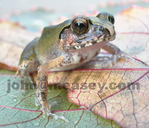|
Arthroleptis stenodactylus Pfeffer, 1893
Common Squeaker, Shovel Footed Squeaker, Dune Squeaker, Savanna Squeaking Frog, Umanswininiza onyawo zingamafosholo (Zulu) | family: Arthroleptidae genus: Arthroleptis |
| Species Description: Pfeffer, G. (1893). Ostafrikanische Reptilien und Amphibien, gesammelt von Herrn Dr. F. Stuhlmann im Jahre 1888 und 1889. Jahrbuch der Hamburgischen Wissenschaftlichen Anstalten 10: 69–105. | |
 © 2006 John Measey (1 of 14) |
|
|
|
Description Distribution and Habitat Country distribution from AmphibiaWeb's database: Angola, Botswana, Congo, the Democratic Republic of the, Kenya, Malawi, Mozambique, South Africa, Tanzania, United Republic of, Uganda, Zambia, Zimbabwe
Life History, Abundance, Activity, and Special Behaviors The breeding season is between December and February. Females deposit eggs in burrows or small depressions in damp earth, under cover or bushes. Egg clutches consist of 33-80 eggs which are creamy white in color and approximately 2 mm in diameter. This species has direct development; there are no free swimming tadpoles (Channing 2001). Arthroleptis stenodactylus becomes most active late in the day (Stewart 1967). This frog eats a variety of insects and other arthropods, along with snails, earthworms, and other frogs. It is preyed upon by many types of snakes including the Olive Marsh snake Natriciteres olivacea and the Green Water snake Philothamnus hoplogaster, as well as other frogs (Channing 2001). It has been reported to hibernate in low-branched trees (Passmore and Carruthers 1995). Trends and Threats Relation to Humans Comments
References
Channing, A. (2001). Amphibians of Central and Southern Africa. Cornell University Press, Ithaca, NY. IUCN, Conservation International, and NatureServe. 2006. Global Amphibian Assessment. www.globalamphibians.org. Accessed on 18 July 2007. Minter, L.R., Burger, M., Harrison, J.A., Braack, H.H., Bishop, P.J., and Kloepfer, D. (eds.) (2004). Atlas and Red Data Book of the Frogs of South Africa, Lesotho and Swaziland. Volume 9 SI/MAB Series. Smithsonian, Washington D.C.. Passmore, N. and Carruthers, V. (1995). South African Frogs, a Complete Guide. Witwatersrand University Press, Johannesburg, South Africa. Phaka, F.M., Netherlands, E.C., Kruger, D.J.D., Du Preez, L.H. (2019). Folk taxonomy and indigenous names for frogs in Zululand, South Africa. J Ethnobiology Ethnomedicine 15, 17. [link] Stewart, M.M. (1967). The Amphibians of Malawi. State University of New York Press, New York. Originally submitted by: Rupi Mudan (first posted 2005-11-01) Edited by: Kellie Whittaker (2023-05-31) Species Account Citation: AmphibiaWeb 2023 Arthroleptis stenodactylus: Common Squeaker <https://amphibiaweb.org/species/1432> University of California, Berkeley, CA, USA. Accessed May 15, 2025.
Feedback or comments about this page.
Citation: AmphibiaWeb. 2025. <https://amphibiaweb.org> University of California, Berkeley, CA, USA. Accessed 15 May 2025. AmphibiaWeb's policy on data use. |



 Map of Life
Map of Life